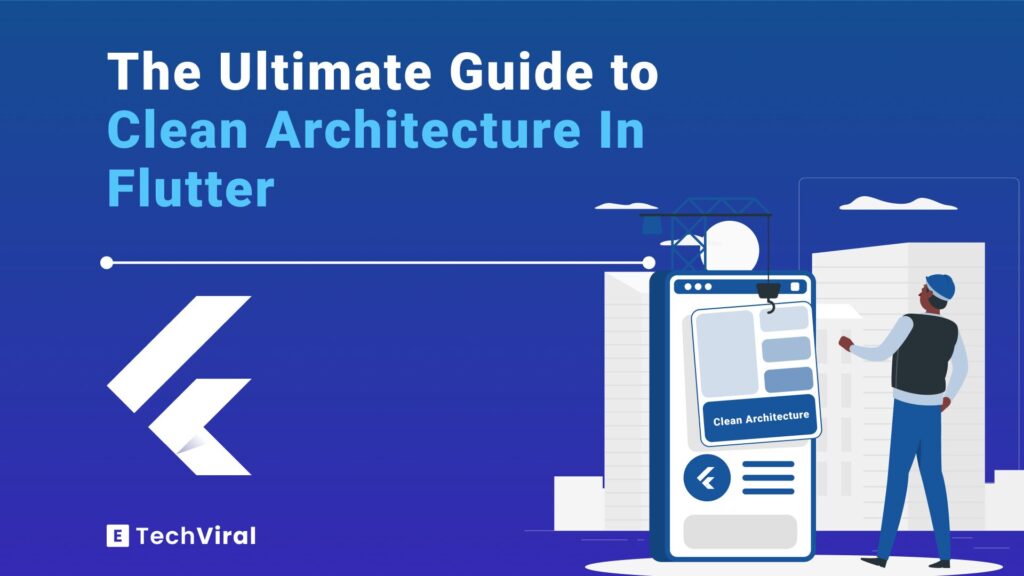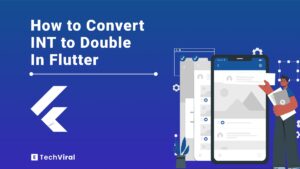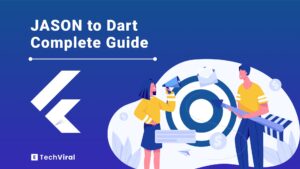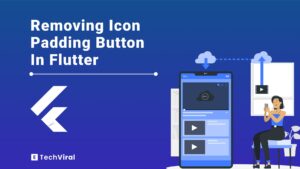Welcome to our in-depth guide on Clean Architecture in Flutter. This resource is tailored for developers who aspire to enhance their Flutter applications through the principles of Clean Architecture.
Whether you’re deeply experienced or just beginning in the world of Flutter, grasping the concept of Clean Architecture is essential.
It’s a key to building scalable, maintainable, and robust mobile apps. In this guide, we’ll thoroughly explore both the theory and practice of Clean Architecture within Flutter, providing you with a comprehensive understanding that’s vital for your Flutter development journey.
Let’s Dive deep into the world of Clean Architecture in Flutter with us.
Part 1: Foundations of Clean Architecture
Basic Principles of Clean Architecture
At its core, architectural design in software development is about creating robust, scalable, and maintainable systems.
The principles of Clean Architecture stand out for their focus on separation of concerns, a concept that ensures different parts of an application are independent yet cohesively work together.
This architectural approach emphasizes the importance of making software entities independent of frameworks, UIs, and databases, thereby enhancing the adaptability and life span of an application.
Comparison with MVC, MVP, MVVM Architectural Patterns
When we explore architectural patterns in the context of app development, popular models like MVC (Model-View-Controller), MVP (Model-View-Presenter), and MVVM (Model-View-ViewModel) often come into discussion.
Each of these patterns has its unique approach to handling data, user interfaces, and business logic. Clean Architecture, however, sets itself apart by its layered structure, promoting the independence of business rules from the UI and database.
This independence results in easier testing and maintenance, as well as greater flexibility in adapting to changes in technology or business requirements. We have covered Clean architecture vs MVVM in detailed so you can compare both and choose an architecture that suits your project best.
Core Components: Entities, Use Cases, Interface Adapters, Frameworks, and Drivers
Diving deeper, Clean Architecture is structured around a few key components:
- Entities: These are the business objects of your application. In a Flutter environment, entities would be classes that represent the core business rules.
- Use Cases: These encapsulate all the business rules specific to an application. In a Flutter app, use cases control the flow of data to and from the entities.
- Interface Adapters: This layer converts data from the format most convenient for use cases and entities, to the format most convenient for some external agency such as a database or a web interface.
- Frameworks and Drivers: The outermost layer of Clean Architecture, this consists of tools like databases, web frameworks, and UI frameworks (like Flutter), which are used to build the application.
How to use clean architecture in flutter
Implementing Clean Architecture in a Flutter application involves structuring your project into these layers and ensuring that dependencies flow inwards from the innermost entities to other layers.
This setup in Flutter development not only streamlines the development process but also makes your application more testable and modular.
It allows Flutter developers to focus on business logic without being tied down by external elements like databases and user interfaces.
Part 2: S.O.L.I.D Principles in Dart
Learn SOLID Principles in Dart programming language from real examples from the video
The S.O.L.I.D principles are foundational to writing clean and maintainable code in any object-oriented programming language, including Dart, the language used in Flutter.
These principles guide developers in creating software that is easier to manage, extend, and refactor.
Single Responsibility Principle (SRP)
The SRP suggests that a class should have only one reason to change, meaning it should have only one job or responsibility.
In the context of Dart programming, this translates to designing classes that handle a single aspect of your application’s functionality. This approach simplifies debugging and enhances the clarity of your code.
Open/Closed Principle (OCP)
This principle states that software entities like classes, modules, functions, etc., should be open for extension but closed for modification. In Dart, this means you can add new features without changing the existing code.
This is often achieved through the use of interfaces or abstract classes, allowing for the extension of behaviors without altering existing implementations.
Liskov Substitution Principle (LSP)
LSP asserts that objects of a superclass should be replaceable with objects of its subclasses without affecting the correctness of the program. In Dart, this principle encourages developers to ensure that subclasses maintain the behavior expected by the superclass, leading to more reliable and predictable code.
Interface Segregation Principle (ISP)
ISP advises that clients should not be forced to depend on interfaces they do not use. When applying this principle in Dart, it encourages the creation of specific interfaces rather than one general-purpose interface. This results in more targeted and flexible code implementations.
Dependency Inversion Principle (DIP)
DIP Principle states that, high-level modules should not depend on low-level modules and low-level modules should not depend on high-level modules both should depend on abstraction and abstractions should not depend on details.
Moreover, In practical terms for Dart and Flutter development, this means that high-level components—like your app’s logic—should dictate how and what low-level components—like data sources or utilities—should perform, but not how they are implemented.
Part 3: Design & Architecture in Software Development
Fundamentals of Design in Software Development
Design in software development is much more than just aesthetics. It’s about creating solutions that are both effective and efficient. Fundamental design principles include modularity, readability, reusability, and maintainability.
In the Dart programming language, often used in Flutter app development, this translates to creating well-structured code that is easy to read, modify, and extend.
Good design is about foreseeing future changes and challenges, allowing for seamless adaptation without significant reworks. It’s the thoughtful organization of code into logical and functional components, leading to a coherent and elegant software structure.
Understanding Architecture in Software Development
Architecture in software development refers to the high-level structuring of software systems. It’s about making strategic decisions regarding the design and layout of code and systems.
The right architecture ensures that your software can meet current requirements and is prepared for future evolution. In the Flutter ecosystem, understanding architecture is essential for building scalable and robust applications. It involves decisions about how to best structure your Flutter project, how to manage state, how to handle network requests, and more.
A good architecture not only addresses the technical aspects but also aligns with business goals, ensuring that the software is able to deliver value efficiently.
In essence, it serves as a blueprint for both the system and the project, guiding developers through the development process and helping manage complexity.
Part 4: Setting Up and Structuring Your Flutter Project
Initial Steps for Project Initialization in Flutter
Starting a new Flutter project begins with the basic setup. After installing Flutter and setting up your development environment, the first step is to create a new Flutter project. This is typically done using the command line with flutter create project_name.
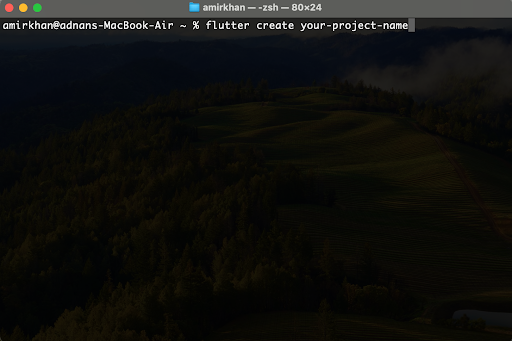
This process generates a standard project structure with some default configuration files and a basic demo app. Before diving into coding, it’s crucial to understand the default structure of a Flutter project. It includes directories for your Dart code, UI assets, and configuration files for various platforms (iOS, Android, web, etc.).
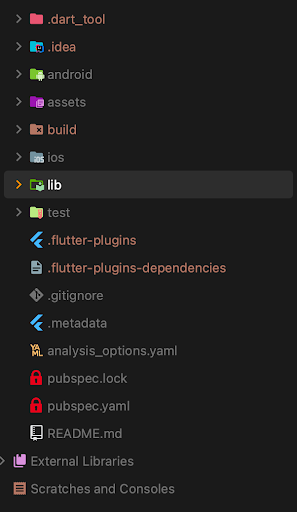
Understanding Clean Architecture in the context of Flutter
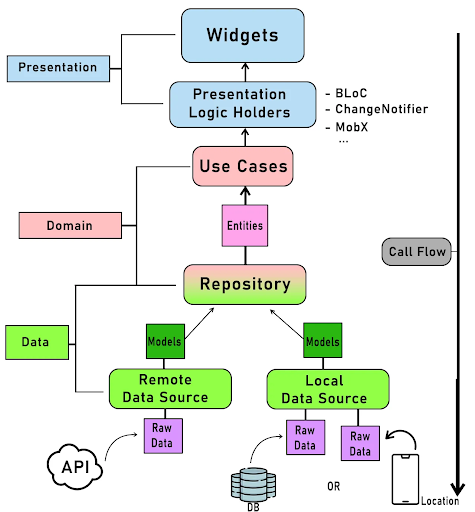
If you want to understand Clean Architecture specifically in the context of Flutter, please watch the video from the link below. There we taught What is Clean Architecture proposed by Robert Cecil Martin AKA Uncle Bob and then we compared it with the Clean Architecture in Flutter specific, also we configured it in flutter project.
Configuring Clean Architecture in Flutter Project
Configuring a Flutter project for Clean Architecture involves structuring your codebase in a way that separates concerns and aligns with the principles of this architectural style. It means dividing the project into layers, typically including Presentation, Domain, and Data layers.
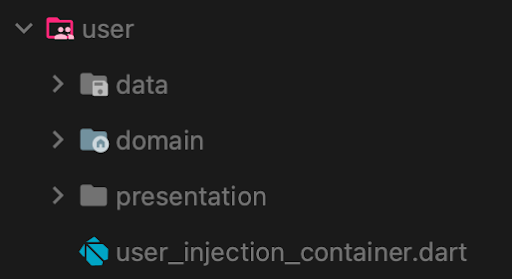
Each layer has a specific role and responsibility:
- The Presentation Layer contains UI-related logic and widgets.
- The Domain Layer holds business logic, entities, and use cases.
- The Data Layer deals with data persistence and network calls, encompassing repositories and data models.
It’s crucial to ensure that these layers interact properly while maintaining a level of independence, typically facilitated by dependency injection in clean architecture.
The injection container you see above in the image, is related to dependency injection which is itself a broad topic and is discussed in detail below.
Best Practices for File and Folder Organization
A well-organized file and folder structure is vital for maintaining the scalability and readability of your Flutter project.
Here are some best practices:
- Organize files logically based on their function. For instance, keep all your UI widgets in a ‘widgets’ folder, and your business logic in a ‘models’ or ‘controllers’ folder.
- Use clear and descriptive names for files and folders, avoiding ambiguity.
- Consider separating UI components into different folders based on their role (e.g., screens, widgets, themes).
- Keep your test files in a parallel structure to your source files for easy navigation.
Benefits: Adhering to these practices not only makes your codebase more maintainable but also eases collaboration with other developers. It allows anyone new to the project to quickly understand the structure and find what they’re looking for.
Part 5: Layered Structure in Clean Architecture
Understanding the Data Layer: Role and Implementation
The Data Layer is fundamental in Clean Architecture, acting as the cornerstone for data management within your application.
In Flutter, this involves handling all data-related operations, including data fetching from the network, data persistence, and data modeling.
The key is to implement this layer in a way that it remains independent of the other layers of your application.
A typical implementation in a Flutter project might include:

- Data Sources: These are the actual sources of data, like network APIs or local databases.
- Repository: They act as intermediaries between data sources and use cases. Repository implements the Repository contract class in Domain Layer, in that way Data Layer depends upon Domain Layer.
- Data Models: These are the structures in which data is stored or represented, often involving conversions to and from JSON for network communication.
Domain Layer: Crafting and Integrating Business Logic
The Domain Layer is where the core business logic of a Flutter application resides. This layer is independent of the user interface or the data source, allowing it to be unaffected by changes in other areas.
Key components include:

- Entities: These are simple data structures that represent the core objects of your business logic.
- Use Cases: Also known as Interactors, these encapsulate specific business rules and are where the application’s most crucial functions are implemented.
- Repository: In Domain Layer, a repository is a contract class which holds the unimplemented use cases of specific features, that are later implemented in Data Layer.
The Domain Layer ensures that your business rules are centralized, testable, and not coupled with the UI or data sources.
Presentation Layer: Building the User Interface
The Presentation Layer in Clean Architecture is all about how the application interacts with the user.
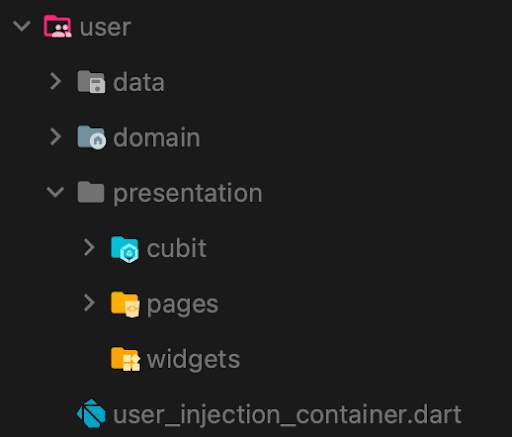
In Flutter, this layer is responsible for:
- Widgets: The building blocks of your Flutter app’s UI. This includes pages, and other custom widgets.
- Controllers/ViewModels: These act as the bridge between your use cases (Domain Layer) and your widgets (UI), managing the data flow and UI logic.
- State Management: State management with clean architecture is crucial aspect controls how your UI responds to changes in the application’s state. Flutter offers various state management solutions like Provider, Riverpod, Bloc, and more.
In this layer, it’s crucial to keep the UI code clean and separated from the business logic, ensuring that the UI is a reflection of the state.
Part 6: Flutter Background Tasks Management
Managing background tasks efficiently is crucial in Flutter to ensure a smooth user experience, especially for operations that are computationally intensive or involve I/O processes. Dart, the programming language used in Flutter, offers a powerful solution for this: Isolates.
Isolates in Dart: Concept and Implementation
Isolates in Dart are similar to threads but without shared memory, ensuring that each isolate has its own memory heap and event loop. This approach allows for concurrent execution, which is particularly useful for tasks that are resource-intensive or need to be run independently.
Implementing isolates in a Flutter app typically involves the following steps:
- Creating an Isolate: You can spawn a new isolate using Isolate.spawn(). This starts the execution of a function in a new isolate.
- Communication: Since isolates do not share memory, communication between them is done via message passing, typically using SendPort and ReceivePort.
- Managing State: Carefully manage the state as data passed between isolates are copied, not shared.
Using isolates, you can keep your Flutter app’s UI smooth and responsive while running complex operations in the background.
Offloading Computations, Network Requests, and I/O Tasks to Isolates
For tasks like data processing, network requests, or I/O operations, isolates come in handy:
- Computationally Intensive Tasks: Operations like image processing or complex calculations can be offloaded to an isolate. This prevents the UI from freezing or becoming unresponsive.
- Network Requests: While network requests are typically asynchronous, handling them in isolates can further optimize performance, especially when dealing with large amounts of data.
- I/O Operations: Reading and writing to local storage or databases can be time-consuming. Executing these tasks in an isolate ensures the main thread remains unblocked.
Part 7: Storing Data Locally in Flutter
Local data storage is a key component in many Flutter applications, especially for saving user preferences, caching data, and maintaining state across sessions. Flutter offers several options for local storage, with Shared Preferences and Hive being two popular choices due to their ease of use and efficiency.
Using Shared Preferences for Lightweight Data Storage
Shared Preferences is a lightweight solution for storing simple data persistently. It’s ideal for storing small pieces of data, like user settings or flags, in key-value pairs.
Here’s how you can use Shared Preferences in a Flutter app:
- Adding the Dependency: Include the Shared Preferences package in your pubspec.yaml file.
- Reading and Writing Data: Use the Shared Preferences instance to store and retrieve data. For example, you can save a boolean value indicating whether the user has seen an onboarding screen and retrieve it to decide the initial route of your app.
- Asynchronous Operations: Since Shared Preferences works asynchronously, ensure that your read and write operations consider this. Use async and await to handle these operations without blocking the UI.
Shared Preferences is not meant for complex or large datasets but is perfect for simple, lightweight data storage.
Implementing the Hive Package for Local Storage
For more complex local storage needs, Hive is an excellent choice. It’s a fast, lightweight, and easy-to-use NoSQL database. It stores data in the form of key-value pairs but can handle more complex data types, including custom objects.
To use Hive in your Flutter app:
- Adding Hive to Your Project: Like Shared Preferences, start by adding Hive to your pubspec.yaml.
- Initializing Hive: Before using Hive, you need to initialize it. This is typically done in the main function before your app starts.
- Defining Models: If you plan to store custom objects, you’ll need to define Hive models. Hive uses TypeAdapters to serialize and deserialize these objects.
- CRUD Operations: Hive provides a straightforward API for creating, reading, updating, and deleting data. You can open a box (a storage unit in Hive), perform your operations, and close the box when done.
Hive is a great choice for applications that require more complex data structures or faster read/write operations than what Sharedpreferences offers.
In order to learn to implement Hive in your Flutter app, head on over to the blogpost on Medium.
Part 8: Essential Components in Clean Architecture
Understanding the essential components of Clean Architecture is key to successfully implementing it in Flutter applications. These components help in organizing code, making it more testable, maintainable, and scalable.
The Role and Implementation of Dependency Injection
Dependency Injection (DI) is a design pattern that allows a piece of code to have its dependencies provided rather than creating them internally. DI is crucial in Clean Architecture for decoupling the creation of objects from their usage. This separation enhances testability and modularity.
In Flutter:
- Choosing a DI Package: There are several packages available for DI in Flutter, like provider, get_it, and injectable. Choose one that best fits your project needs.
- Setting Up DI: Configure your chosen DI package in your project. This typically involves setting up a DI container or service locator that holds instances of your classes.
- Injecting Dependencies: Use the DI framework to inject dependencies where needed, such as injecting a repository into a use case or a service into a view model.
In order to fully dive into Dependency Injection (DI) in the context of flutter with a real time project, watch this 16 minute video which will clear all of your confusions related to DI and using it in Flutter.
Note: The Video above is one part of Flutter and firebase bootcamp if you want to learn complete app development from scracth in practical ways in free of cost you should check the specification of this Flutter and firebase bootcamp that what you will learn from it.
Repositories With Clean Architecture: Data Handling and Persistence Strategies
Repositories act as intermediaries between the data layer and the rest of the application. They abstract the data sources from the rest of the app and provide a clean API for data access.
For effective data handling:
- Define Repositories: Create repository classes that encapsulate data access logic.
- Use Abstractions: Define abstract classes or interfaces for your repositories to decouple them from their implementations.
- Data Sources: Implement different data sources (like local database, network, etc.) and let your repositories manage them.
Implementing and Structuring Use Cases
Use cases encapsulate all the business rules specific to an application. They are part of the domain layer and act as the intermediary between the presentation layer and the data layer.
In structuring use cases:
- Define Use Cases: Each use case should represent a single action or process in the application.
- Clear Responsibilities: Ensure that each use case has a clear and singular responsibility.
- Interaction with Repositories: Use cases should interact with repositories to fetch or store data, keeping themselves unaware of the data source specifics.
Part 9: Error Management and Asynchronous Operations
Effective error management and the handling of asynchronous operations are crucial in ensuring the reliability and responsiveness of Flutter applications, especially when applying Clean Architecture principles.
Best Practices for Error Handling and Exception Management
Error handling in Flutter clean architecture is not just about preventing crashes; it’s about ensuring a smooth user experience even when things go wrong.
Here are some best practices:
- Try-Catch Blocks: Use try-catch blocks to gracefully handle exceptions, especially in places where errors are likely, such as network requests or file operations.
- Custom Exception Classes: Create custom exception classes for your application. This allows for more specific error handling and better clarity in what went wrong.
- Error Reporting: Implement error reporting mechanisms, such as sending error logs to a server or using third-party services. This helps in identifying and fixing issues quickly.
- User Feedback: Provide clear feedback to users when errors occur. For instance, display a message if a network request fails, so the user knows what happened.
If you want to learn exception handling in Flutter, check out the Dart Crash Course video below.
Managing Asynchronous Operations in Flutter
Asynchronous programming is a core aspect of Flutter, particularly when dealing with IO-bound tasks like network requests or database transactions.
Here’s how to manage asynchronous operations effectively:
- Async-Await: Use the async-await syntax to make asynchronous code more readable and maintainable.
- Handling Futures: Understand how to work with Futures, which represent a potential value or error that will be available at some time in the future.
- Stream API: For continuous data like user input or a data feed, use the Stream API. It allows you to process asynchronous events as they occur.
- Error Handling in Asynchronous Code: Ensure to handle errors in asynchronous operations. For example, use catchError on Futures and handleError on Streams.
Part 10: Testing Your Flutter Application
Testing is a fundamental aspect of software development, crucial for ensuring the reliability and quality of your Flutter application. In Clean Architecture, the clear separation of concerns makes your code more testable. Here’s how to approach testing in Flutter:
Overview of Testing Strategies in Flutter Clean Architecture
- Unit Testing: This involves testing individual functions, methods, or classes in isolation. In the context of Flutter and Clean Architecture, unit tests commonly focus on business logic in the domain layer. Use the test package for writing unit tests, ensuring each test is independent and tests only one aspect of the code.
- Integration Testing: Integration tests check how different parts of your application work together. This includes testing the interaction between widgets, services, and data layers. The flutter_test package provides tools for writing integration tests, allowing you to simulate user interaction and verify integrated workflows.
- End-to-End (E2E) Testing: E2E tests validate the entire application workflow from start to finish, similar to how a real user would interact with the app. These tests are crucial for ensuring the overall system functions as intended. Flutter’s integration_test package can be used for writing E2E tests, simulating complete user journeys.
Implementing Effective Testing in Clean Architecture
- Testing Layers Separately: Given the layered structure of Clean Architecture, test each layer independently. For example, test use cases in the domain layer without worrying about UI or data sources.
- Mocking and Stubbing: Use mocking frameworks, like mockito, to simulate the behavior of dependencies. This is particularly useful for testing components in isolation, such as testing use cases without actual data layer implementation.
- Continuous Testing: Integrate testing into your development process. Consider setting up a CI/CD pipeline to run tests automatically, ensuring that every change in the codebase is tested.
- Test Coverage: Aim for high test coverage but focus on the quality of tests. It’s not just about covering lines of code but about testing the right scenarios and ensuring the tests are meaningful.
If you want to overcome the headeach of errors and testing you should try the clean architecture with TDD (Test driven development).
Part 11: Advanced State Management
Effective state management is pivotal in Flutter applications, particularly when integrating with Clean Architecture. It ensures that your app’s UI is consistent and responsive to changes in the underlying data. Let’s delve into the techniques and strategies for state management and how they tie into Clean Architecture.
Techniques and Strategies for State Management in Flutter
Choosing the Right Tool
Flutter offers various state management solutions like Cubit, Getx, Riverpod, Provider, Bloc, and Redux. Each has its strengths and suits different use cases. Provider and Riverpod are great for simplicity and scalability. Bloc is excellent for complex state management with a clear separation of presentation and business logic. Redux suits applications with a large app state requiring a centralized store.
If you want to understand how to use these solutions with clean architecture must read:
- Clean architecture with Getx
- Clean architecture with Bloc
- Clean architecture with Provider
- Clean architecture with riverpod
- Clean architecture with Cubit
Understanding Stateful vs. Stateless Widgets
In Flutter, widgets are either stateful or stateless. Knowing when to use each is crucial. Stateless widgets are immutable, meaning their properties can’t change—all values are final. Stateful widgets maintain state that might change during the lifecycle of the widget. Use stateful widgets sparingly and only when necessary.
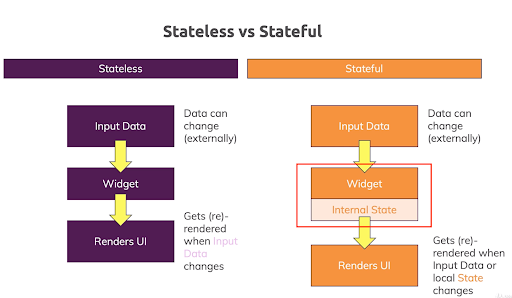
Effective Use of Context: Understanding the context in Flutter is essential for managing state. It’s a handle to the location of a widget in the widget tree and is used to access data from ancestors in the tree.
In order to dive even more deeper into the BuildContext in flutter watch the following video:
Integrating State Management with Clean Architecture
Decoupling State Management
In Clean Architecture, the Presentation Layer should handle the UI state. Decouple state management from business logic by using the chosen state management solution to manage UI-related state only.
Using Use Cases for Business Logic
Keep your business logic within use cases in the Domain Layer. The state management solution in the Presentation Layer should interact with these use cases, ensuring a clear separation of concerns.
Streamlining Data Flow
Ensure a unidirectional data flow for predictability and maintainability. Data should flow from your repositories (Data Layer) through use cases (Domain Layer) and end up in your state management solution (Presentation Layer), where the UI reacts to changes in the state.
Testing State Management
As with any other part of your app, test your state management thoroughly. This includes testing the integration of state management with UI components and use cases.
Part 12: Performance Considerations and Optimization
In Flutter development, performance is key to ensuring a smooth and responsive user experience. Applying performance considerations and optimization techniques is crucial, especially when dealing with complex architectures like Clean Architecture.
Methods for Enhancing Flutter App Performance
- Efficient Widget Use: Understand and utilize the performance implications of different widgets. For instance, prefer const constructors where possible, and use ListView.builder for long lists to build items lazily.
- Minimizing Expensive Operations: Keep your build methods lean. Offload computationally expensive tasks (like parsing a large JSON) to background threads using Isolates to avoid blocking the UI thread.
- State Management Optimization: Optimize your state management approach. Redundant rebuilds can lead to performance issues. Ensure that only widgets that need to react to specific state changes are rebuilt.
- Image Optimization: Images often consume significant memory. Use appropriately sized images, cache images, and consider using image formats like WebP for better performance.
- Avoiding Unnecessary Builds and Layout Passes: Use tools like the Flutter DevTools to identify widgets that are being rebuilt unnecessarily and optimize them.
Profiling and Debugging Tips
- Using Flutter DevTools: Flutter DevTools is a suite of performance tools for profiling, inspecting the UI and layout, and diagnosing performance issues. Familiarize yourself with these tools to understand where bottlenecks may be occurring.
- Performance Profiling: Regularly profile your app in profile mode (not just in debug mode). This provides a more accurate representation of your app’s performance and helps identify issues that don’t show up in debug mode.
- Memory Profiling: Monitor memory usage with Flutter DevTools. Look for memory leaks and ensure that disposed objects are being garbage collected.
- Network Profiling: If your app makes network requests, use network profiling to monitor these requests and optimize them. This includes reducing the number of requests, compressing data, and handling errors properly to avoid unnecessary retries.
- Benchmarking: Implement benchmark tests for critical parts of your application. This helps in detecting performance regressions and understanding the impact of your optimizations.
In order to learn more about flutter performance, and how you can build performant apps in flutter, you need to understand how flutter renders widgets. Checkout the detailed video or the written tutorial about how flutter render widgets works under the hood.
Part 13: Integrating with External Services
In the modern app development landscape, integrating with external services like APIs is a common requirement. For Flutter apps, particularly those following Clean Architecture, it’s important to handle these integrations in a way that maintains app performance and reliability.
Best Practices for API Integration and Network Communication
Using Reliable Libraries
Choose robust libraries for network communication. In Flutter, http and dio are popular choices for making HTTP requests. They provide a high-level abstraction over lower-level networking tasks.
Asynchronous Handling
Always handle network requests asynchronously. Use Dart’s Future and async/await patterns to make your network calls without blocking the main thread.
Efficient Data Serialization
When dealing with JSON data, efficient serialization and deserialization are key. Dart provides json_Encode and json_Decode methods, and you can use libraries like json_serializable for more complex scenarios.
Caching Responses
Implement caching mechanisms to store API responses. This reduces the number of network requests, saving bandwidth and decreasing load times.
Error Handling
Implement comprehensive error handling for network requests. Handle different types of errors like network unavailability, timeouts, or API-specific errors gracefully.
Securing API Calls
Ensure security in API calls by using HTTPS, adding proper authentication, and protecting sensitive data.
Handling API Responses and Errors Efficiently
- Parsing Responses: Parse API responses carefully. Ensure your app can handle unexpected or missing data without crashing.
- Using Model Classes: Convert API responses to model classes. This not only makes the data easier to manage but also integrates well with the rest of your Clean Architecture setup.
- Error Handling Strategy: Develop a strategy for handling API errors. This might include showing error messages to users, retrying requests, or defaulting to cached data.
- Timeouts and Retries: Implement timeouts and retry mechanisms for your API calls. This ensures your app remains responsive even if an external service is slow or unavailable.
- Testing API Integration: Thoroughly test your API integration. Use mock responses and test for various scenarios, including success, failure, and edge cases.
Part 14: UI Design and Implementation in Flutter
In Flutter app development, the user interface plays a crucial role in determining the success of your application. It’s not just about how the app looks, but also how it behaves across different devices and platforms. Implementing responsive and adaptive UI design patterns is essential to cater to a diverse user base.
Responsive and Adaptive UI Design
Responsive design in Flutter is about creating a UI that looks great and functions well on any screen size. Utilize Flutter’s layout widgets like MediaQuery, Flexible, and AspectRatio for adaptable layouts. It’s not only about scaling to different screen sizes but also about adjusting the layout and content to fit various devices effectively.
Adaptive design takes it a step further by considering platform differences. Flutter allows for platform-specific UI adjustments using its rich set of widgets and the Platform class. This helps in delivering a native experience on both Android and iOS platforms.
For example, navigation patterns differ between these platforms, and adapting your UI accordingly can greatly enhance user experience.
Watch the video to learn how to build a responsive and adaptive design in flutter:
Building Effective UI Components
Creating custom widgets in Flutter offers endless possibilities for unique and engaging UI designs. Understanding how to craft these custom widgets is vital. They should not only be visually appealing but also functional and interactive.
Managing the state of your UI is another critical aspect. An effective state management approach ensures that your UI responds correctly to user interactions and data changes. Incorporate subtle animations using Flutter’s animation framework to make the UI more interactive and lively.
Furthermore, consider accessibility and internationalization. Your UI should be accessible to all users, including those with disabilities. Internationalizing your app involves supporting multiple languages and cultural nuances, like right-to-left text for certain languages.
Lastly, always be mindful of performance. A beautiful UI that leads to sluggish performance can detract from the user experience. Optimize your UI components to avoid unnecessary rendering and heavy animations that might cause performance issues.
Incorporating Flutter Hooks for Cleaner Code
As we delve into building effective UI components and managing their state, it’s crucial to highlight the role of Flutter Hooks in achieving cleaner and more concise code. You can use Flutter Hooks for clean code, it is a library that introduces Hooks, a new kind of object that manages a Widget lifecycle, allowing for more reusable and modular components.
By utilizing Hooks, developers can abstract complex logic out of their widgets, leading to a reduction in boilerplate and an increase in code readability and reusability. Hooks simplify state management, side effects, and accessing other Flutter lifecycle mechanisms. They seamlessly integrate with existing Flutter applications and encourage a functional approach to widget development, aligning well with Clean Architecture principles by further decoupling the presentation layer’s logic from its visual representation.
Part 15: Building Modular and Scalable Applications
In the realm of Flutter development, building applications that are both modular and scalable is essential for long-term maintenance and adaptability. This approach allows for easier updates, better organization, and more efficient collaboration, especially in larger projects.
Strategies for Creating Modular Components
Component-Based Design
Break down your UI into smaller, reusable components (widgets in Flutter). This modular approach not only makes the code more manageable but also enhances reusability and testability. For example, create a custom widget for a commonly used button style or a specific layout pattern.
Decoupling Components
Ensure that each component has a single responsibility and is decoupled from others. Use dependency injection and abstract classes or interfaces to achieve this. Decoupling components makes them more versatile and easier to test and maintain.
Directory Structure
Organize your codebase with a clear directory structure. Group related files together and separate different layers of your application (like UI, logic, and data). A well-organized directory structure aids in navigating the codebase and managing different aspects of your application more efficiently.
Approaches to Scaling Flutter Applications
State Management Scalability
Choose a state management solution that scales well with your application’s complexity. Solutions like Provider, Riverpod, Bloc, or Redux can handle varying degrees of complexity and help manage the state in large applications effectively.
Code Generation
Utilize code generation tools for boilerplate code to speed up development and reduce human error. Tools like build_runner and packages like json_serializable can automate parts of your code, making the development process more efficient.
Performance Optimization
As your application grows, continuously monitor and optimize its performance. Use profiling tools to identify bottlenecks, optimize resource-intensive tasks, and ensure that your app runs smoothly.
Automated Testing
Implement automated testing to ensure that new changes do not break existing functionality. Unit tests, widget tests, and integration tests are crucial for maintaining application stability as it scales.
Continuous Integration/Continuous Deployment (CI/CD)
Set up CI/CD pipelines to automate the testing and deployment processes. This helps in maintaining code quality and accelerates the release process.
Part 16: Refactoring and Migrating Existing Flutter Apps
Transitioning existing Flutter apps to Clean Architecture and managing legacy code are crucial steps in enhancing an application’s structure, maintainability, and scalability. This process requires careful planning and execution to ensure a smooth transition.
Guidelines for Transitioning to Clean Architecture
Understanding Clean Architecture
Before starting the transition, ensure a thorough understanding of Clean Architecture principles. Familiarize yourself with its layers and how they interact.
Incremental Refactoring
Instead of a complete overhaul, refactor your application incrementally. Identify the most critical parts of your app that would benefit from transitioning to Clean Architecture and start there. This approach reduces risk and allows you to learn and adjust your strategy as you go.
Layer by Layer Approach
Begin by separating the business logic from UI code. Gradually move towards a more layered structure, segregating data, domain, and presentation layers.
Testing
As you refactor, maintain a strong emphasis on testing. Write tests for new code and update existing tests to accommodate changes. This ensures that your application remains stable throughout the transition process.
Handling Legacy Code and Refactoring
Code Analysis
Start by analyzing the existing codebase. Identify areas of high complexity and tightly coupled components that could benefit from refactoring.
Prioritize Refactoring Efforts
Prioritize refactoring tasks based on factors like business value, complexity, and stability. Focus on parts of the code that are most prone to bugs or are frequently changed.
Establish Clear Interfaces
Create clear interfaces between different parts of your application. This helps in decoupling components and makes it easier to replace or update individual parts in the future.
Documentation
Document your refactoring process and architectural decisions. This is crucial for maintaining clarity and consistency, especially in team environments.
Continuous Integration
Utilize continuous integration to automatically build and test your application as you refactor. This helps in catching issues early and ensures that the application remains functional.
Part 17: Exploring Advanced Concepts
As you grow more comfortable with Flutter and Clean Architecture, exploring advanced concepts and tackling complex scenarios becomes pivotal for developing sophisticated, feature-rich applications. This exploration not only enhances your skill set but also allows you to push the boundaries of what’s possible in your applications.
Implementing Complex Scenarios in Flutter
Custom Animations and UI Interactions
Dive into custom animations to create dynamic, engaging user interfaces. Understand the nuances of the Flutter animation framework, from simple tweens to complex, coordinated animations.
Handling Advanced User Inputs
Implement custom gesture handling for more complex user interactions. This can include multi-touch gestures, drag-and-drop interfaces, and custom input forms.
Learn how basic drag & drop works in flutter:
Integrating with Hardware and Third-Party Services
Explore how to interface with device hardware (like cameras and sensors) and third-party services (like payment gateways or social media APIs). This includes both the technical implementation and handling permissions and security concerns.
Asynchronous Programming and Concurrency
Master asynchronous programming patterns for dealing with concurrent operations, background processing, and synchronizing data across different parts of your application.
Advanced Design Patterns in Clean Architecture
Domain-Driven Design (DDD): Explore DDD principles to guide the design and development of your application, focusing on complex business domains. This approach helps in creating highly scalable and maintainable systems.
Microservices and Modular Architecture: For large-scale applications, consider a microservices approach or modular architecture. This involves breaking down the application into smaller, independent modules or services that can be developed, deployed, and scaled separately.
CQRS and Event Sourcing: Investigate advanced architectural patterns like Command Query Responsibility Segregation (CQRS) and Event Sourcing. These patterns can be particularly beneficial in applications with complex business logic and data handling requirements.
Design Patterns and Best Practices: Stay updated with emerging design patterns and best practices in the Flutter and Clean Architecture communities. Regularly review and refactor your code to align with these best practices.
Part 18: Flutter Clean Architecture for Large-Scale Applications
As Flutter applications grow in scale and complexity, adopting Clean Architecture becomes even more critical. Large-scale projects come with their own set of challenges, such as managing complex features, ensuring consistent performance, and facilitating effective collaboration among large teams.
Managing Complex Projects in Flutter
Modularization
Breaking down the application into smaller, manageable modules or packages helps in isolating functionalities and managing complex features. Modularization also aids in parallel development across different teams.
Scalable State Management
For large-scale applications, choose a state management solution that can handle complex scenarios and a large number of states efficiently. Solutions like Bloc or Redux can be more suitable for such cases.
Performance Optimization
Regularly monitor and optimize the performance of your application in flutter clean architecture. This involves efficient memory management, optimizing render cycles, and ensuring smooth animations, especially for applications with a large user base.
Robust Testing Strategy
Implement a robust testing strategy that covers unit tests, integration tests, and end-to-end tests. This ensures that all features work as expected and new changes do not introduce bugs.
Ensuring Team Collaboration and Code Consistency
Code Review and Pull Request Workflow
Implement a code review process where every piece of code is reviewed by other team members before it is merged. This ensures code quality and consistency.
Continuous Integration (CI) and Continuous Deployment (CD)
Set up CI/CD pipelines to automate the testing and deployment processes. This not only saves time but also reduces human errors.
Documentation and Coding Standards
Maintain comprehensive documentation of your architecture, codebase, and development processes. Establish coding standards and guidelines to ensure code consistency across the team.
Version Control Best Practices
Utilize version control systems like Git effectively. Implement branching strategies like Git Flow or Trunk Based Development to manage features, fixes, and releases systematically.
Agile Methodology
Adopt an agile methodology for project management. This allows for flexible planning, progressive development, iterative releases, and encourages adaptive and collaborative work environments.
Part 19: CI/CD in Flutter Projects
Implementing Continuous Integration (CI) and Continuous Deployment (CD) is a significant step in professionalizing your Flutter project workflow. These practices are essential for maintaining high code quality, automating testing and deployment, and ensuring that your development process is efficient and scalable, especially in team environments.
Continuous Integration in Flutter
CI involves automatically building and testing your application every time a change is made and committed to the version control system. This practice helps in identifying and fixing issues early, improving code quality, and reducing integration problems.
In Flutter, you can set up CI by:
- Selecting a CI Platform: Choose a CI platform that integrates well with your version control system (like GitHub Actions, GitLab CI, or Bitrise for Flutter).
- Automating Builds and Tests: Configure the CI pipeline to automatically build your app and run tests (unit, widget, and integration tests) on every commit or pull request. This ensures that any code changes do not break the existing functionality.
- Linting and Code Analysis: Include steps in your pipeline for code linting and static analysis to maintain code quality and consistency.
Continuous Deployment in Flutter
CD extends the concept of CI by automatically deploying your application after it has been built and tested successfully. This allows for rapid and reliable software release cycles.
To implement CD in your Flutter project:
- Automated Deployment: Set up your CD pipeline to automatically deploy builds to test environments, beta testers, or production. Tools like Fastlane can be used to automate the deployment to app stores.
- Environment Management: Configure different environments (development, staging, production) and manage environment-specific configurations efficiently.
- Release Management: Implement strategies for managing releases, including versioning, tracking changes, and rollback mechanisms in case of issues.
Part 20: Documentation and Code Maintenance in Flutter Clean Architecture
In the world of software development, thorough documentation and diligent code maintenance are as crucial as the code itself, especially when working with a structured approach like Clean Architecture in Flutter. These practices ensure that the application remains understandable, adaptable, and maintainable over time.
Best Practices for Documenting Clean Architecture
1. Clearly document the architectural choices made in your Flutter project. This includes the rationale behind using Clean Architecture, how the layers are structured, and the flow of data within the application.
2. Utilize comments and docstrings effectively within your code. Describe the purpose and functionality of major classes, methods, and functions, especially those within the domain and data layers. This aids in understanding the business logic and data handling aspects of your application.
3. If your application exposes APIs or interacts with other services, maintain comprehensive API documentation. This could include request/response formats, endpoint descriptions, and usage examples.
4. Visual representations of your architecture, like flow diagrams or layer diagrams, can greatly aid in understanding the overall structure and flow of your application.
5. Ensure that your documentation is kept up-to-date with the code. Outdated documentation can lead to confusion and errors.
Strategies for Effective Code Maintenance
1. Regularly refactor your code to improve efficiency, readability, and performance. In Clean Architecture, this might involve simplifying complex use cases, optimizing data layer operations, or improving the interaction between layers.
2. Implement a code review process where peers review code changes. This not only helps in maintaining code quality but also ensures that more than one team member is familiar with different parts of the codebase.
3. Use version control systems like Git effectively. Implement branching strategies that suit your team’s workflow, and ensure that commit messages are clear and descriptive.
4. Maintain a robust suite of automated tests. This includes unit tests for business logic, integration tests for inter-layer interactions, and end-to-end tests for overall application flow.
5. Be mindful of technical debt
– The extra development work that arises when code that is easy to implement in the short run is used instead of applying the best overall solution. Regularly assess and address technical debt, balancing new feature development with the need to improve existing code.
Continuous Learning
Stay updated with the latest Flutter and Clean Architecture developments. The technology and best practices in this space are continually evolving, so keeping your knowledge and skills current is vital.
Part 21: Community Engagement and Continuous Learning
In the fast-evolving world of software development, staying updated and continuously learning is crucial. Engaging with the Flutter community and leveraging resources for continuous learning in Clean Architecture are invaluable for personal and professional growth.
Engaging with the Flutter Community for Knowledge Sharing
- Participate in Forums and Groups: Platforms like Stack Overflow, Reddit, and Flutter community forums are great places to ask questions, share knowledge, and stay updated on the latest trends and best practices.
- Contribute to Open Source: Engaging with open-source projects can be a powerful way to learn. Contributing to Flutter packages, plugins, or even the Flutter framework itself can provide deep insights into advanced concepts and practical challenges.
- Attend Meetups and Conferences: Participate in Flutter meetups, webinars, and conferences. These events are excellent opportunities to connect with other developers, learn from experts, and share your experiences.
- Social Media and Blogs: Follow Flutter and Clean Architecture experts on social media platforms like Twitter and LinkedIn. Reading and contributing to blogs can also enhance understanding and visibility in the community.
Resources for Continuous Learning in Clean Architecture
- Online Courses and Tutorials: Platforms like Udemy, Coursera, and Pluralsight offer courses on Flutter and Clean Architecture. Regularly engaging with these resources can help in keeping your skills sharp.
- Books and E-Books: There are several comprehensive books on Flutter and software architecture principles. Titles like ‘Flutter for Beginners’ and ‘Clean Architecture: A Craftsman’s Guide to Software Structure and Design’ can offer in-depth insights.
- Official Documentation: The Flutter official documentation and Clean Architecture guidelines are invaluable resources. They offer the most up-to-date and reliable information directly from the source.
- Coding Challenges and Hackathons: Participate in coding challenges and hackathons. These activities can provide practical experience and often expose you to new and innovative ways of thinking and coding.
- Peer Learning Groups: Join or form study groups with peers. Collaborative learning can be very effective, providing different perspectives and shared experiences.
Part 22: Staying Ahead of The Future Trends and Practices
In Software Engineering, particularly in areas like Flutter and Clean Architecture, staying informed about future trends and evolving practices is crucial for staying
ahead of the curve. This proactive approach enables developers to adapt to new changes, leverage emerging technologies, and continuously refine their skills.
Keeping Up with Evolving Practices in Flutter and Clean Architecture
Monitoring Flutter Updates
Stay updated with the latest releases and updates from Flutter. This includes not just new features but also changes in best practices, performance improvements, and deprecated functionalities. Regularly visiting the Flutter GitHub repository and following the Flutter development team’s blog can provide first-hand information on these updates.
Exploring Emerging Technologies
Keep an eye on emerging technologies that could integrate with or impact Flutter development. This includes advancements in cross-platform tools, new programming paradigms, or enhanced hardware capabilities like augmented reality (AR) and virtual reality (VR) support.
Adopting Modern Clean Architecture Practices
Clean Architecture is not a static methodology. As new patterns and tools emerge, adapt your approach to Clean Architecture accordingly. This might involve incorporating new design patterns, refining layer interactions, or adopting more efficient data handling techniques.
Participating in Beta Testing
Engaging with beta versions of Flutter and related tools can provide early insights into upcoming features and changes. This allows you to prepare in advance for any significant shifts in the development process.
Networking with Industry Experts
Building connections with industry experts can provide valuable insights into future trends and practices. Engaging in discussions, attending talks, and following thought leaders on social media can offer foresight into the direction of Flutter and Clean Architecture.
Continuous Skill Development
Dedicate time for continuous learning. This could involve taking advanced courses, attending workshops, and experimenting with new tools and libraries. The goal is to maintain a growth mindset that embraces change and innovation.
Part 23: Security Best Practices in Flutter Clean Architecture
Implementing security best practices in Flutter Clean Architecture is essential for protecting both the application and its users. Firstly, always use HTTPS for network requests to encrypt data in transit. Implement certificate pinning to prevent man-in-the-middle attacks. For data storage, utilize secure storage options like Flutter Secure Storage to encrypt sensitive data on the device.
Adopt authentication mechanisms such as OAuth2 for secure access, and ensure tokens are stored securely. Regularly update dependencies to mitigate vulnerabilities. Use static analysis tools to identify potential security issues early. Lastly, follow the principle of least privilege by requesting only necessary permissions and segregating duties within the app architecture. These practices help in maintaining a robust security posture within a Flutter application using Clean Architecture.
Conclusion
Throughout this comprehensive guide, we’ve explored the multifaceted aspects of implementing Clean Architecture in Flutter, emphasizing its significance in building robust, maintainable, and scalable applications.
From the foundational principles to advanced concepts, we delved into strategies that enhance both the performance and quality of Flutter apps.
As we conclude, remember that the journey with Clean Architecture and Flutter is one of continuous improvement and exploration.
Adopt the evolving nature of technology, stay engaged with the community, and keep learning. By doing so, you’ll not only refine your skills but also contribute to the ever-growing and vibrant world of Flutter development.
FAQ’s
Can Clean Architecture be used in small Flutter projects?
Yes, Clean Architecture can be implemented in small Flutter projects to future-proof them as they grow. Starting with Clean Architecture early on encourages good design practices, making it easier to scale, maintain, and add new features without significant rework. It helps in keeping the code organized and flexible from the outset.
How does Clean Architecture affect Flutter app performance?
Clean Architecture, when implemented correctly in Flutter apps, can positively impact performance. By separating concerns, it ensures that business logic and UI are not tightly coupled, making the codebase easier to manage and optimize. However, it may require careful consideration of dependency injection and state management to prevent any potential performance bottlenecks.
Is it necessary to use specific state management solutions with Clean Architecture in Flutter?
While Clean Architecture doesn’t mandate the use of specific state management solutions, it requires a clear separation of concerns, which many state management patterns provide. Solutions like Provider, Bloc, or Riverpod are commonly used with Clean Architecture to efficiently manage state while keeping the code clean and maintainable.
How does Clean Architecture integrate with existing Flutter projects?
Integrating Clean Architecture into existing Flutter projects involves refactoring the codebase to align with its principles. This usually starts with segregating the project into layers (Presentation, Domain, Data) and may require significant changes to how data flows through the app. It’s a gradual process that benefits from careful planning and incremental implementation.
Can Flutter Hooks replace traditional state management in Clean Architecture?
Flutter Hooks can complement traditional state management by simplifying the lifecycle management of widgets and reducing boilerplate. However, they don’t replace the need for state management solutions that handle app-wide state. Instead, Hooks work well within the presentation layer to manage widget-specific state and effects.
What are the common pitfalls when implementing Clean Architecture in Flutter?
Common pitfalls include over-engineering the application by introducing unnecessary complexity, misunderstanding the separation of concerns leading to tightly coupled layers, and improperly managing dependencies, which can all negate the benefits of Clean Architecture. Avoid these by thoroughly understanding Clean Architecture principles and applying them judiciously.
How can developers keep up with changes in Clean Architecture practices for Flutter?
Developers can stay updated on Clean Architecture practices for Flutter by following the community through forums, blogs, and social media. Participating in conferences, workshops, and webinars is also beneficial. Continuously experimenting with new tools, reading about emerging patterns, and contributing to open-source projects are excellent ways to keep skills sharp and stay informed.

